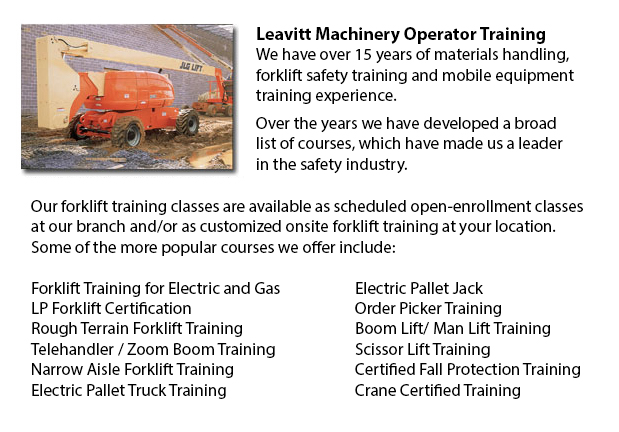
Oakville Aerial Lift Safety Training - There are approximately 26 to 30 construction deaths within North America attributed to the utilization of aerial lifts. Most of those killed are craftsmen like for example painters, electrical workers, laborers, carpenters or ironworkers. Nearly all deaths are caused by electrocutions, falls and tip-overs. The greatest hazard is from boom-supported lifts, like cherry pickers and bucket trucks. Nearly all fatalities are connected to this particular kind of lift, with the rest involving scissor lifts. Other hazards consist of being struck by falling objects, being thrown out of a bucket, and being caught between the lift bucket or guardrail and an object, like a steel beam or joist.
The safe operation of an aerial lift needs an inspection on the following things prior to making use of the device: operating and emergency controls, safety devices, personal fall protection gear, and tires and wheels. Look for possible leaks in the air, hydraulic fluid and fuel-system. Check the device for missing or loose parts.
The areas where worker will use the aerial device should be examined thoroughly for possible dangers, like for example holes, bumps, debris and drop-offs. Overhead powerlines need to be avoided and monitored. It is suggested that aerial lift devices be utilized on surfaces which are level and stable. Don't work on steep slopes which exceed slope restrictions which the manufacturer specified. Even on a level slope, wheel chocks, outriggers and brakes must be set.
Employers are needed to provide maintenance mechanics and aerial lift operators with the proper guidebooks. Operators and mechanics must be trained by a certified person experienced with the relevant aerial lift model.
Aerial Lift Safety Tips:
o Close doors or lift platform chains prior to operating.
o Leaning over and climbing on guardrails is prohibited. Stand on the platform or floor of the bucket.
o Utilize the provided manufacturer's load-capacity limitations.
o When working near traffic, use appropriate work-zone warnings, such as cones and signs.
Electrocutions are avoidable if safety procedures are followed. Stay well away from power lines - at least 10 feet. Qualified electrical workers must insulate and/or de-energize power lines. Workers should make use of personal protective equipment and tools, like a bucket that is insulated. However, a bucket which is insulated does not protect from electrocution if, for instance, the individual working touches another wire providing a path to the ground.
Falls are avoidable if the worker remains secure inside guardrails or inside the bucket by using a full-body harness or a positioning device. If there is an anchorage in the bucket, a positioning belt with a short lanyard is adequate.
By following the manufacturer's directions, tip-overs can be avoided. Never drive the lift platform when it is elevated, unless otherwise specified by the manufacturer. Adhere to the vertical and horizontal reach limits of the device, and never go beyond the load-capacity that is specified.
-
Oakville Overhead Crane Safety Training
Oakville Overhead Crane Safety Training - Overhead crane safety training equips operators with skills and knowledge regarding crane safety measures, accident avoidance, materials handling, and machinery and stock protection. Trainees will learn the t... More -
Oakville Crane Training Schools
Oakville Crane Training Schools - Our various Mobile Crane Operation programs are designed for skilled operators who needs re-certification or certification, and for inexperienced individuals who are seeking their very first job as an operator of a c... More -
Oakville Overhead Crane Certification
Oakville Overhead Crane Certification - The overhead crane certification course is a course that is designed to help trainees, even though they have language or literacy limits. The course consists of a classroom theory part and a practical hands-on... More -
Oakville Forklift Training Programs
Oakville Forklift Training Programs - If you are searching for work as an operator of a forklift, our regulatory-compliant forklift training programs provide exceptional instruction in various types and styles of forklifts, classes on pre-shift inspe... More -
Oakville Fall Protection Ticket
Oakville Fall Protection Ticket - The number one cause of death in the construction business come from fall-related accidents. There is more possibility for fall accidents depending on the types of work being performed within your workplace. Thus, be... More -
Oakville Zoom Boom Training
Oakville Zoom Boom Training - Zoom Boom Training focuses on correctly training potential operators on variable reach forklifts. The training objectives consist of gaining the understanding of the machine's physics and to define the job of the operato... More -
Oakville Aerial Lift Ticket
Oakville Aerial Lift Ticket - A boom truck is often recognized by the cable and telephone company vans that have the elongated arm folded over their roofs. Commonly, a bucket-like apparatus sits at the extension of extendable arms. Often referred to... More -
Oakville Scissor Lift Training
Oakville Scissor Lift Training - Scissor lifts need to be operated competently to be able to protect the safety of the machinery and the safety of people in the workplace. Operators who are skilled are trained to drive the specific model of scissor l... More

Forklift Certification Oakville
TOLL FREE: 1-888-254-6157
Oakville, Ontario
forkliftcertificationoakville.com
Email Us
About Us


